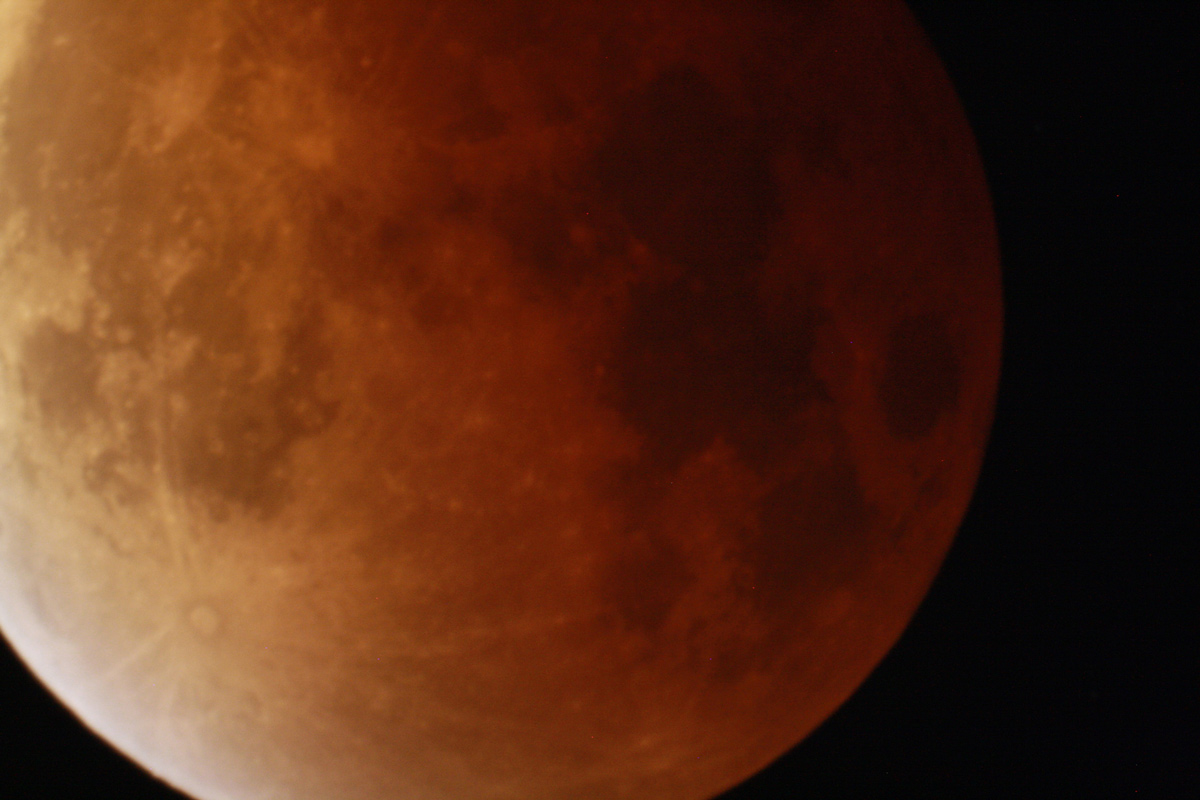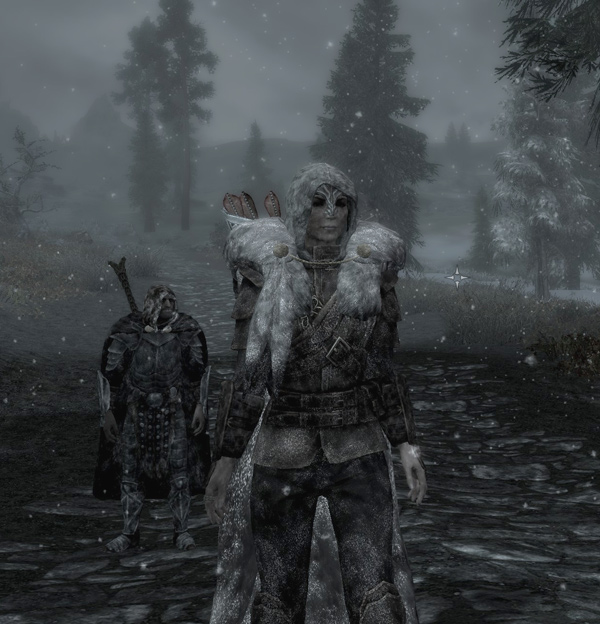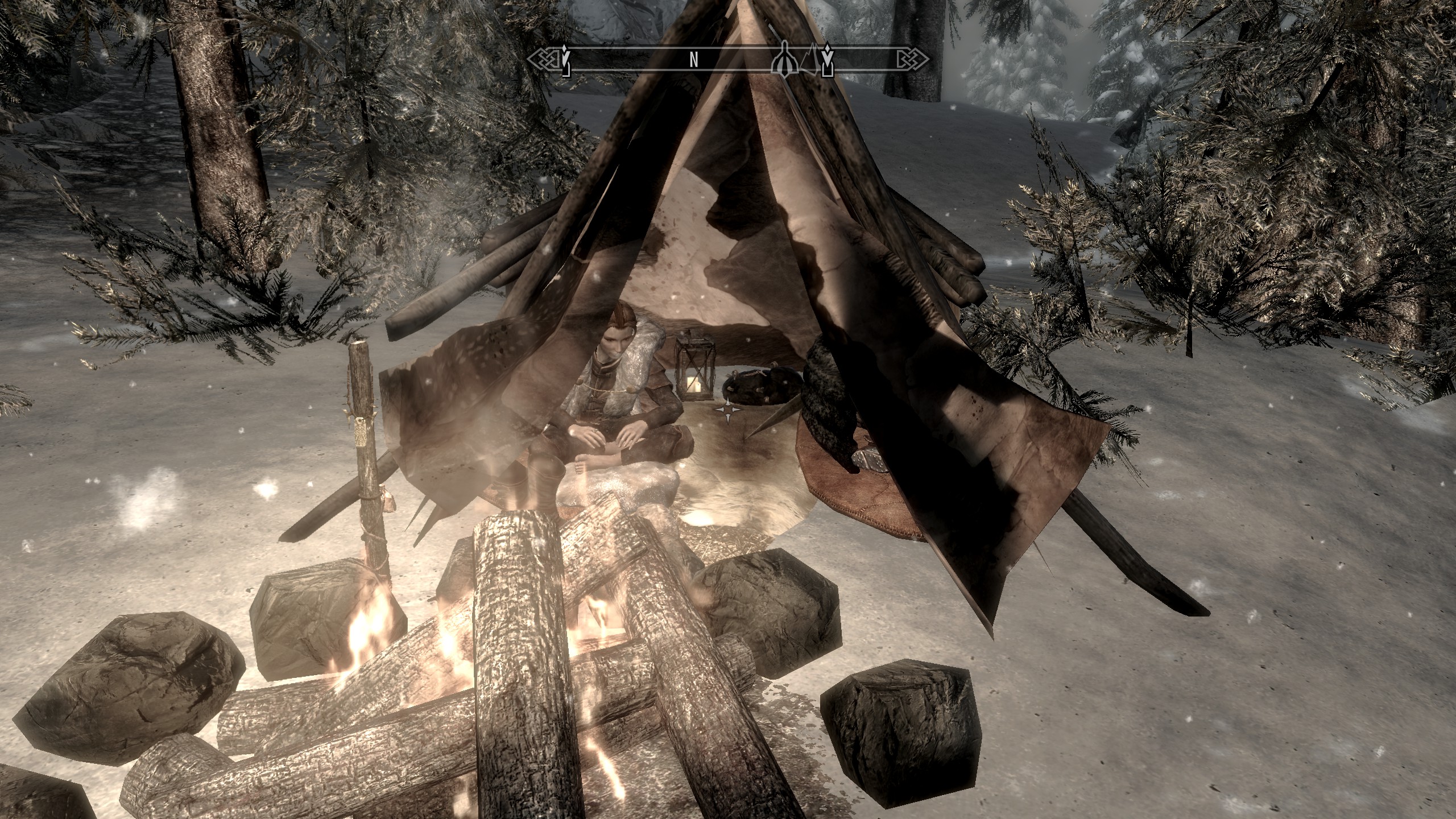Posts
Lunar Eclipse 2015-09

The Harvest Super Moon total lunar eclipse last night I captured with a Canon Rebel attached to a Celestron C8 telescope used like a big telephoto lens. The shutter was held open for approximately five seconds. In the past I’ve counted the seconds, but this time I let the Canon Rebel decide calculated on the light using the standard P setting. It did a nice job. So as not to shake the camera, I used a wired shutter button.
Skyrim Immersion: Environment
Article #2 in a 12-part series.
- 1 - Upgrade Skyrim with Mods
- 2 - this article
- 3 - Pretty Skyrim: Elements
- 4 - Skyrim Life
- 5 - How to Install Skyrim Body Mods, Dual Sheath, and Animations
- 6 - Pretty Skyrim People
- 7 - Skyrim Gear 1: Clothing
- 8 - Skyrim Gear 2: Akavir
- 9 - Skyrim Gear 3: Light Armor
- 10 - Skyrim Gear 4: Heavy Armor
- 11 - Setup for Script Work with Bethesda's Creation Kit and Notepad++
- 12 - Body Conversions for Skyrim Using BodySlide, Outfit Studio
There are aspects of “Frostfall - Hypothermia Survival” that should have been in the original TES V: Skyrim. Frigid air means dressing warm. In a blizzard, but too far out from Winterhold? Make camp and wait out the storm. After swimming in near-freezing water seek a fire to avoid hypothermia. “Frostfall” created by Chesko adds survival skills along with some gear and spells to help endure the journey.
Now this is Skyrim!

Immersion vs realism
Skyrim is an RPG. Even though combat is action-oriented and characters freely move about, dice rolls and movement turns take place. Time is compressed in game not just so day and night pass quicker, but also to scale the land. Have you noticed how indoors seem bigger than outside of the buildings? The land is compressed. It’s about 12 miles between Whiterun and Rorikstead if measured by characters traveling just over 2 hours (game-time) at a quick-pace. Outside of combat, a minute in real-time is 20 minutes in game-time. Picking berries becomes less time-consuming and tedious. This also implies that conversations actually last longer than the voice-overs and limited response choices, details left to the imagination.
Improving immersion doesn’t always mean making the game more realistic. This is a fantasy world for one. Secondly, some things we want to compromise on, such as landscape sizes and time. Things that jolt the player out of the moment, are out of character, or seem too unnatural are contenders for immersive updates. We can imagine our characters doing extra details within the time-scaled world such as removing the hide from a wolf, eating, or stopping to tinkle. It’s tougher to imagine a guard sleeping in bed clothes when the visuals show him sleeping in armor, helmet and all. Weather doesn’t need to be realistic. It should enhance the mood for the story.
Sometimes realism could be called just making sense to the player. Let’s take for example how the lanterns and braziers across Skyrim remain lit during the day. It seems to make sense using a mod to turn off all braziers and outdoor lanterns at sunrise. Not so fast! Notice how characters warm their hands near braziers? Windhelm is notable for this. It’s cold in Skyrim, and braziers keep citizens warm. One problem with being disconnected from the environment is that common sense doesn’t come as easy. Before considering immersive changes, the player should try to think like a character living in Skyrim.
Immersive mods should maintain consistency with the lore and support the fantasy feel of the game within reasonable limitations of game mechanics.
Improving immersive behavior, items, and atmosphere helps hold the role-playing mood. Fixing things that break continuity also improves immersion. Characters commenting on the cold is fine, but that character dressed in basic clothing while calmly holding a conversation during a blizzard breaks continuity. As does sleeping or swimming dressed in full plate-male armor. These little details remind us something isn’t right.
Let’s look at some mods created by the community to improve immersion in the environment.
Continue reading...Apps Updated for iOS 9

Dee Count and Draco Calculation have been updated for iOS 9 supporting split-view and slide-over view. This means you can play Calculation while working on something else, or copy-paste more efficiently between another app and Dee Count. Note in Dee Count in slide-over view the camera will not be available for bar code scanning. Use in primary mode. These new views are available on iPad Air and newer devices.
Last year for iOS 8, Apple hinted that these new iPad features would be coming by reminding developers to prepare for these new views. I took it to heart a year ago and found that Apple’s changes to views make better sense for a more open design targeting different screen shapes and sizes. Split-view on iPad Pro should be a big step up for productivity.
Upgrade Skyrim with Mods
Article #1 in a 12-part series.
- 1 - this article
- 2 - Skyrim Immersion: Environment
- 3 - Pretty Skyrim: Elements
- 4 - Skyrim Life
- 5 - How to Install Skyrim Body Mods, Dual Sheath, and Animations
- 6 - Pretty Skyrim People
- 7 - Skyrim Gear 1: Clothing
- 8 - Skyrim Gear 2: Akavir
- 9 - Skyrim Gear 3: Light Armor
- 10 - Skyrim Gear 4: Heavy Armor
- 11 - Setup for Script Work with Bethesda's Creation Kit and Notepad++
- 12 - Body Conversions for Skyrim Using BodySlide, Outfit Studio
When I played The Elder Scrolls V: Skyrim for the first time in 2011, I became immediately pulled into the Nord’s land with its rugged landscape and varied characters offering a multitude of quests. I also reacted with a few chuckles and head-shakes, not even counting the bugs. Why do warriors sleep in armor? Nevermind that follower swimming in plate-male armor. No one suffers dressed in regular clothing out in a blizzard, or care about getting soaked in the rain. My biggest gripe in the first week of playing was all the dialogue about how cold and harsh Skyrim is, yet it isn’t. Bland scenery and lack of cold hold this chapter back.
Assuming the next chapter in The Elder Scrolls (TES) series is several years away as in “a long ways off” (PC Gamer), now is a fine time to bring new life to Skyrim. Add new quests, update visual details for modern hardware, or add new immersive features. Swimming in frigid water or wearing light clothing in the snow should be risky. Skyrim could be much prettier, too. Bethesda Game Studios offers a Creation Kit for creating mods, but in this post I’ll go over selecting existing mods created by the community. In future posts I’ll cover in more detail on improving immersion and making Skyrim prettier.
Normally I advise experiencing the plain game first, but I make an exception this time. If you’ve never played Skyrim before, I recommend adding two mods (a package, really) before you even begin your adventure. “Frostfall” with “Campfire” is a well-designed immersive update with at least some gameplay features that should have been part of the original game. I’ll go over “Frostfall” in more detail in my post on improving immersion. Read this post if you’ve never tried mods, or have never played Skyrim.
Also see “Skyrim Special Edition Released” for modding the 2016 edition.

Project CARS - Patch v3.0 = 1.0
This review covers the PC version updated in 2016.

Project CARS by Slightly Mad Studios is an immersive race-simulation game similar to Forza Motorsport or Gran Turismo, but more race oriented. The most impressive part of Project CARS is the weather making racing feel more immersive and challenging. Endurance racing with real-time daylight progression is a great experience. The career mode is extensive with enough racing to keep players busy for a long time in addition to online racing series and hotlap competitions. Holding this simulator back, though, have been the bugs. Three months later, patch 3.0 is starting to look like what version 1.0 should have been. Overall, Project CARS is welcome for those who enjoy longer races and other race strategies such as pit stops, night driving, and changing weather.
I enjoyed Forza Motorsport until 4 when longer races went away along with the challenge. I also missed greater racing realism of older Papyrus titles. Upon hearing of Project CARS and World of Mass Development (WMD) back in late 2012, I became interested. The goal of the WMD project was to get input (and crowdfunding support) from fans on the direction of the title. Early suggestions including large number of cars, tracks, and racing styles such as off-road rally, but some features were set aside to focus on finishing the game. I became concerned after the second release delay was announced, and then a third, as the game likely still needed much polishing. My concern became reality upon trying the initial release to find many bugs, some amusing and others cringe-worthy, along with controls that didn’t feel right making some cars difficult to drive.
Previously, I went over force feedback and Fanatec controller setup making a big improvement with the driving experience.
Continue reading...